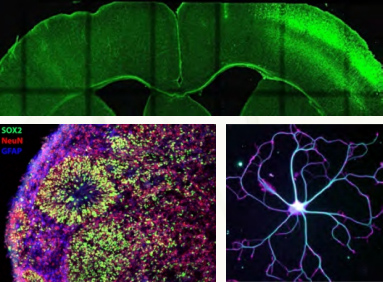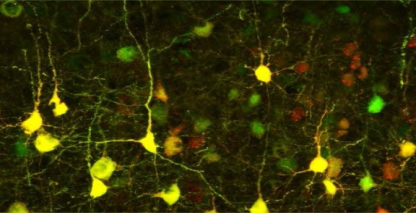
Clockwise from top: cortical section, hippocampal neuron, cerebral organoid.
The mission of the Cellular Neuroscience, Neurodevelopment and Neurodegeneration Group is to boldly move the field of cellular neuroscience forward in transformational ways that change the course of basic science while dramatically shifting paradigms for disease treatment strategies. Rather than following the crowd, our approach is to think out of the box, innovate and forge new directions.
We have a robust multidisciplinary sub-focus on cellular neuroscience, neurodevelopment and neurodegeneration. This research group starts with basic cellular and developmental neuroscience, with cutting-edge mechanistic studies on questions such as:
- How axons and dendrites grow?
- How neurons migrate?
- How growth cones find their targets?
- How organelles are trafficked in the neuron?
Other studies delve into signaling pathways, genetics and epigenetics. Model systems include human induced pluripotent stem cells, mouse models for neurological disorders, as well as rodent primary cell cultures.
Building on the basic science themes that are strong among the faculty, an ever-growing level of attention in the group is devoted to neurodevelopmental disorders and neurodegenerative diseases.
Our approach combines mechanistic basic science and disease-oriented research so that entirely new insights can drive our efforts toward novel therapies.
We have a highly collaborative atmosphere wherein the expertise and insights of multiple teams in three departments (Neurobiology & Anatomy, Pharmacology & Physiology and Biology) combine to drive projects forward:

Neurons in the cortex.
Disease etiology and treatment
Tauopathies
A group of disorders involving aberrations to the microtubule-associated protein tau. (Baas, Fischer, Qiang, Raghupathi)
Gulf War Illness
A chronic disorder suffered by veterans of the first Gulf War exposed to pesticides and nerve agents. (Baas, Qiang, Raghupathi)
Neuro-AIDS
HIV-AIDS adversely affects every system of the body and has profound negative effects on the nervous system. (Meucci, others)
Hereditary Spastic Paraplegia
Corticospinal degeneration leading to gait impairment caused by mutations to the microtubule-serving protein spatin. (Baas, Qiang, collaboration with the Marion Murray Spinal Cord Research Center)
Autism Spectrum Disorders
Genetic mutations affecting early developmental timepoints such as neuronal morphogenesis, migration and cortical connectivity. (Toyooka, collaboration with Gao and the AJ Drexel Autism Institute)
CNS Injuries
Spinal cord injury (SPI) and traumatic brain injury (TBI) are poorly understood mechanistically, and hence effective therapies remain elusive. (Baas, Qiang, Tom, Fischer, Raghupathi)